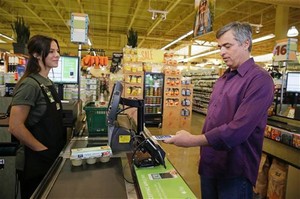How Good Is Apple Pay’s Ecosystem?
How Well Does Apple Pay’s Ecosystem Meet Consumers’ and Partners’ Critical Needs?
How viable is the Apple Pay ecosystem? Will all of the 15 categories of players required to support mobile payments play together nicely? Who benefits the most? Apple? The banks? The credit card companies? The consumers? The merchants? Which of these ecosystem partners stands to lose the most if Apple Pay is successful? What will make the entire ecosystem most viable? If all of the parties required align to support consumers’ four most critical moments of truth for mobile payments.
NETTING IT OUT
Apple Pay—Apple’s mobile payment platform for the iPhone 6 and iWatch—went into use starting October 16, 2014 in at least 220,000 retail locations in the U.S. Within the first week, there were hundreds of positive and negative reports about how easy it was to use.
 We described and analyzed the Apple Pay mobile wallet functionality on October 11, 20141 vis à vis consumers’ top showstoppers when it comes to paying from their mobile phones.
We described and analyzed the Apple Pay mobile wallet functionality on October 11, 20141 vis à vis consumers’ top showstoppers when it comes to paying from their mobile phones.
Our analysis shows that there are 15 different categories of players in any mobile payment ecosystem. The first two categories are the consumers who use the m-wallet and the m-wallet platform provider. In this report, we look at the rest of the supporting ecosystem required to make Apple Pay successful—the 13 additional categories of players.
We evaluate the viability of the Apple Pay ecosystem using the same four customer-critical moments of truth we believe form the basis for any viable mobile payment ecosystem.
WHAT ARE U.S. CONSUMERS’ CRITICAL ISSUES AROUND MOBILE E-WALLETS?
Mitigate the Showstoppers First!
Before you can build and evolve a customer ecosystem, you need to address the moments of truth that will stop customers from adopting and using your solutions. Once you identify the critical issues that are likely to keep customers from being successful in getting things done, you can mitigate those issues by transforming their fears into positive experiences and/or by understanding and meeting customers’ success criteria.
What Will Keep U.S. Consumers from Adopting Mobile E-Wallets?
© 2014 Patricia Seybold Group Inc.
Here’s our take on U.S. consumers’ showstoppers for mobile phone e-wallets. 1) They’re worried about having their financial assets compromised if they lose their phones. 2) They don’t want to be limited in where they can use it to make payments. 3) They’re worried about having their activities and movements tracked; location-based offers make them nervous! 4) They will insist on portability of their e-wallet information and transaction history from one e-wallet provider and/or phone or phone service provider to another.
We believe that there are four customer-critical issues that need to be addressed proactively to make it easy for U.S. consumers to embrace mobile e-wallets and payment systems:
- It’s not safe! Fear of theft of assets, account information getting into the wrong hands, and identity theft.
- I can’t use it! Inability to pay everywhere I want to shop using my payment type of choice.
- You’re tracking me! Fear of “big brother” or any entity knowing where I am and what I’m doing and making that information available to others without my knowledge or permission.
- Lock-In! Once I start using a mobile e-wallet (assuming it’s safe to do so), how easily can I switch?
In a companion article2, we evaluated the top layer of the Apple Pay ecosystem—the e-wallet functionality and how it stacks up against these four criteria... (more)
(Download the PDF to read the entire article.)
[1] How Apple Pay Stacks Up: How Well Does Apple Pay Meet Consumers’ Critical Needs? By Patricia B. Seybold, October 11, 2014, Customers.com Press, DOI: http://dx.doi.org/10.1571/pp10-10-14cc.
Sign in to download the full article
0 comments
Be the first one to comment.




